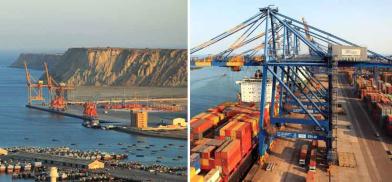Gwadar and Mundra: Strategic importance of two ports to Pakistan and India
Both Gwadar and Mundra ports are close to a turbulent region that is violent and militancy-prone. If Gwadar has security problems from within, Mundra has them from without

It is unusual for a Pakistani journal to publish a study comparing its Gwadar port with India’s Mundra port, given the toxic bilateral relations, sans trade or economic cooperation, and, currently not even having High Commissioners in each other's capitals.
Headlined “What Gwadar can learn from Mundra”, it forcefully suggests that the Indian port, located in Gujarat’s Kutch district in western India, has delivered while Gwadar in Balochistan has not.
The author in Dawn (August 25) is Uzair M. Younus, the director of the Pakistan Initiative at the Atlantic Council’s South Asia Center and a host of the podcast Pakistonomy.
“Mundra’s rise and the strategy followed by Indian policymakers, especially Narendra Modi, first as Chief Minister of Gujarat and then as Prime Minister of India, offers many lessons to Pakistani policymakers seeking to realize the full potential of the Gwadar Port,” says the study.
Mundra vs Gwadar
It commends the private enterprise of the Adani Group, full back-up from successive Gujarat governments since 1994, as also the government at the central level, and the local public support and involvement that ensures jobs and prosperity.
By contrast, Younus cites numerous issues with the state enterprise of Pakistan that has been slow and faltering in development. It is where the security forces have been fighting the ‘nationalist’ Baloch groups and the civil administration, slow in developing the much-needed infrastructure to make a port tick. Pakistan has failed to meet the economic aspirations of the locals, including fishermen who feel deprived of their livelihood.
“The Gwadar projects are also facing other constraints and every day new issues are cropping up, including shortages of water and electricity under its short-term strategy. These shortages have so far slowed down the implementation and development of the project,” The Express Tribune reported on February 5.
Gwador and CPEC
Significantly, Younus confines his study to economic issues and does not touch upon why and how Gwadar port has come to be designed, developed and financed by the Chinese as the southern end of the China Pakistan Economic Corridor (CPEC). It also gives China access to the Indian Ocean and the Gulf, bolstering its presence in the region. That makes Gwadar key to China's geostrategic goals in the region.
Younus does not say so, but that he is working for an American think tank appears to have led to the study being completely ‘sanitized’ of the China factor that could annoy China and Pakistan. As for the US, it is critical of the CPEC. The International Monetary Fund (IMF) has warned Pakistan against using the loan it is seeking to service debts with China.
Noting that Indian billionaire businessman Gautam Adani’s son Karan Adani is the CEO, Younus is all praise for the speed and efficiency of work on Mundra port and its Special Economic Zone (SEZ). “The dramatic success of Mundra and the Adani conglomerate is built on two key foundations — the consistency of policy priorities, especially at the state government level, and the recognition that the private sector is best placed to generate economic activity.”
Gwadar's failure
Hinting at the state’s failure to carry the Baloch population at Gwadar, he contrasts that as well with Mundra. “Mundra’s success was built on this priority, meaning that before the port could play a role in helping India’s broader economic story, it had to have a positive impact on the people who lived in the state of Gujarat.”
He writes that Gwadar is totally state-sponsored with little effort to involve private effort. He notes that political instability has shooed away investors.
Recent media reports indicate that Chinese projects are being opposed by Pashtun militants in the north and by the Balochs in the south, the latter being more effective in their operations despite heavy security deployment.
Younus asks: “Can a major port, that is unable to deliver for the people that live closest to it, generate economic opportunity and wealth that benefits Pakistan and its citizens?”
Balochistan instability
He laments that “the lack of political stability in Balochistan and the machinations that are the norm in Quetta, means that there is little local ownership in terms of tackling the province’s chronic economic and human development challenges”.
Despite Younus’ praise, however, when seen from an Indian perspective, Mundra is the answer to the loss of Karachi in 1947, which Kandla could not be despite efforts for long years. Mundra came up belatedly, only after the government decided to privatize the port sector.
India’s interest in Chabahar port in Iran that it has developed has also fluctuated, partly because of the American hostility to any dealing with Iran, but lately interest has picked with the visit there of India's Ports and Shipping Minister Sarbananda Sonowal. India must not waste this opportunity.
Security issues
There is the security angle. Both Gwadar and Mundra ports are close to a turbulent region that is violent and militancy-prone. If Gwadar has security problems from within, Mundra has them from without. It is very much on the drug trail that emanates from Afghanistan and seeks maritime access.
The seizure of 3,000 kg of narcotics last September is still under probe. The authorities need to guard against a Mumbai-style terror attack.
Lastly, if the Gujarat coast escaped a sea-side attack during the 1971 India-Pakistan conflict, it was in part because of the Indian Navy’s offensive on Karachi harbour. Another conflict on the Arabian Sea could be many times more complicated for India, what with the Chinese presence at Gwadar where Beijing could seek to play a role to defend its property and personnel.
(The author is a veteran journalist and South Asia watcher. Views are personal. He can be reached at mahendraved07)










Post a Comment